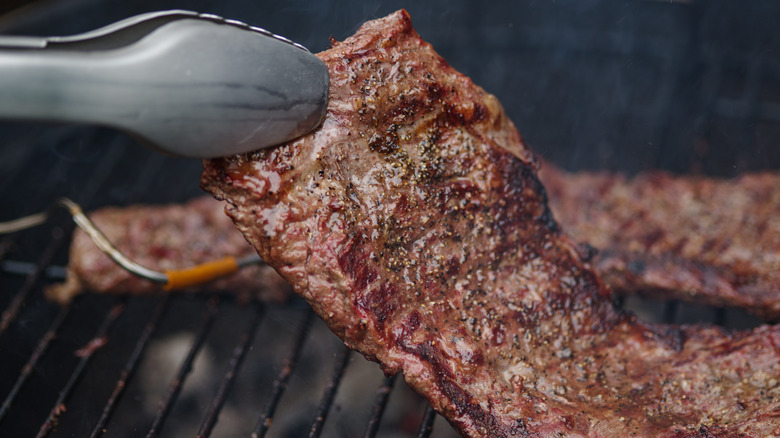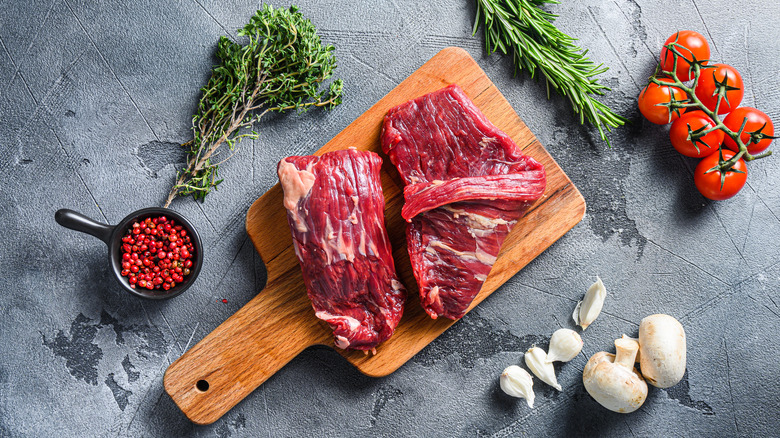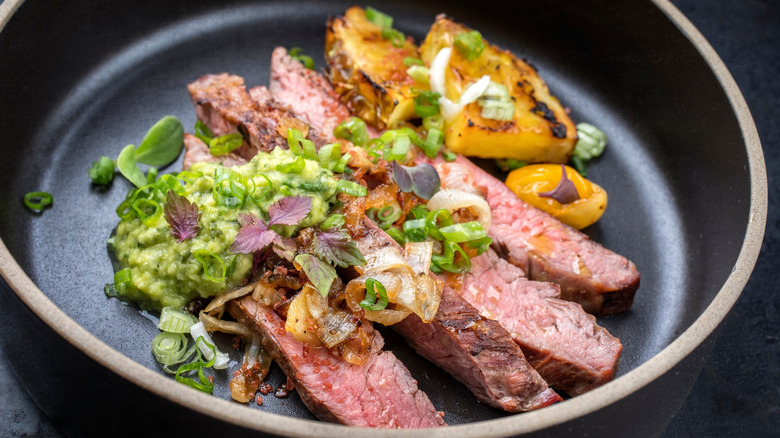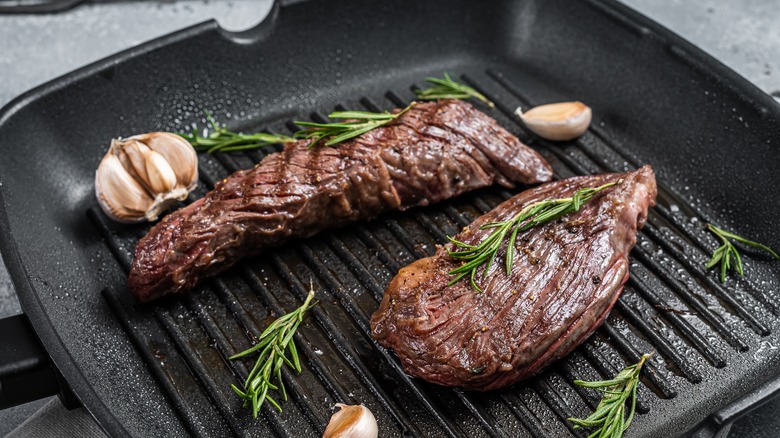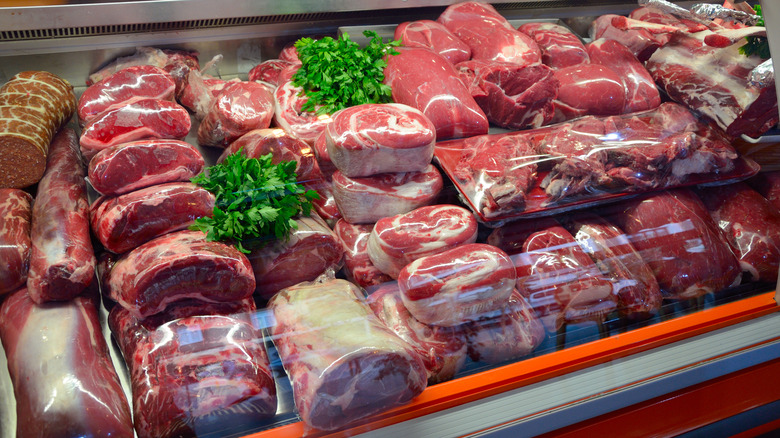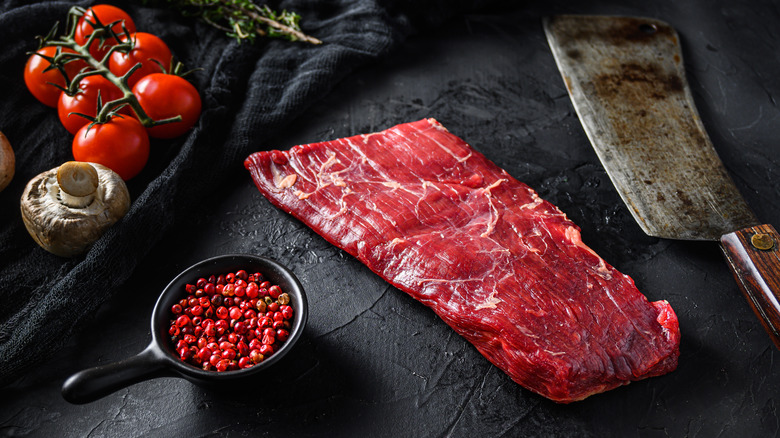Everything You Need To Know About Bavette Steak
Bavette steak is the unsung hero of beef. Also known as "flap steak," the bavette cuts are flat, flexible in texture, and often contain a great ratio of muscle and fat, according to Steak Revolution. This abundance of fat makes the bavette highly flavorful as well as easy to cook. Because of bavette steaks' size and shape, they are best used for any dish that requires the steak to be sliced into many pieces. They are perfect for large gatherings since they can be cut into different portions and cooked separately to differentiate internal doneness so that everyone is happy.
Although bavette steak checks almost all the boxes on your steak wishlist, there is one area that can be improved — accessibility. Per Boat Basin Cafe, bavette steak can most likely not be found in your local supermarket. Your local butcher, however, should have this excellent cut available. The only problem is that bavette steak has earned the nickname "the butcher's cut," because butchers often save it for themselves. Before searching for your first bavette steak, here's everything you need to know to ensure you do so thoughtfully.
Where it's cut from
The name "bavette" is the French word for "bib," in reference to the cut's shape and location on the cow. Bavette steaks come from the region of the cow next to the one that includes flank and skirt steak, but the qualities of these three cuts should not be categorized together, per Food Fire Friends.
Technically, the bavette cut is cut from the bottom sirloin at the intersection of the sirloin, short loin, and flank. This location is found deeper inside the cow, further away from the exterior, where the muscles are not exercised as often. The less exercise a muscle gets, the more tender it will be (since the muscle is more relaxed). This is one reason why bavette steak is a step above flank steak. The flank of the cow is exercised so often that the muscle fibers are built up and fat content is burned off. Accordingly, flank steaks are tougher cuts of beef and are more precarious to cook properly.
The location where the bavette comes from, on the other hand, has a far better fat ratio, which contributes to its tenderness and flavor. Per Food Fire Friends, this fat content does not result in stringiness or chewiness like it sometimes does in skirt steak. The fibers in bavette cuts are more open and loose. This wider grain means the muscle fibers are not as tightly fastened, making them more receptive to marinades.
Best uses for bavette steak
As previously stated, the open fibers of bavette steak make it a great vehicle for marinades and seasonings. Full Of Steak reports the flavor of bavette is very robust, so the beef flavor will not get lost behind whatever you add to it. A cut like flank steak tends to have its beefiness overpowered in well-seasoned dishes, but bavette will remain the star of the show as well as enhance its supporting cast. Regardless, bavette is just as delicious, hearty, and satisfying simply seasoned with salt and pepper. This piece of meat is a powerhouse. It's often known as a cheap, but just as delicious, alternative to ribeye steak.
Also, this cut's flat, uniform width makes it perfect for filling tortillas in dishes such as fajitas or tacos or tossed with similarly sized items such as in a steak salad or stir fry. Whatever you've been using your flank steak for, bavette can take its place and elevate that dish to a whole new level.
How to cook it
As is the case for almost every cut of steak, some preparation is required. Although fat content is one of the benefits of bavette steak, trimming any excess is necessary to achieve the best result possible (via Steak Revolution). Also, your cut of bavette may have some silver skin left on it, which will have to be removed. Other than that, patting it dry and seasoning or marinating it to your liking is all that remains before it hits the heat.
Bavette can be cooked in a variety of ways, but the most important thing to remember when cooking is the temperature. Bavette with a thin and crusty exterior is always best. Therefore, low or medium heat will not do, as the inside will cook before the outside is properly browned. Super high heat is your most reliable option, as the interior will come up to temperature just as the crust is dried and lightly charred.
Bavette steak is a great option for your next backyard cookout and is perfect for the grill. The grill grates will mark the steak nicely and impart all those smoky flavors into the beef. Plus, bavette can be sliced after cooking for large groups of people to take as much as they'd like. If you want to enjoy some bavette in the cold weather or do not have access to a grill, a ripping hot cast-iron skillet will get the job done just as well.
It's more common than you think
When shopping for bavette steak, it is important to remember the names it is known by; in particular, flap steak. Because the bavette is cut from the "flap" of the bottom sirloin and "bavette" is not an English word, the cut will most likely be labeled "flap steak" in an American grocery store. While bavette steak is not a common find in your local supermarket, it is more commonly available in Mexican grocery stores, notes Eat Like No One Else.
Your best bet is to call your local butcher shop or pop in for a look. As stated earlier, bavette has earned the nickname of "the butcher's cut" because some butchers are keen to reserve it for themselves. This nickname is more of a testament to how tasty bavette steak is and is not a universal truth. If your local butcher is good at what they do, they should have bavette steak available. Whether you come across it in a market, in your local butcher shop, or just on a restaurant menu, the odds are in your favor for a pleasant experience.
What's the cost?
Another great positive for bavette steak is that is generally inexpensive. It is widely considered that skirt steak is an improvement on flank steak, but skirt steak will cost you, especially if feeding the entire family or a larger gathering. Bavette, however, is not only an improvement on both skirt and flank steak, but it provides a great bang for your buck. At The Woodruff Farm, one order of bavette steak is $17 per pound. This checks out with Sanagan's Meat Locker, as its cuts of bavette are typically available in 8-ounce portions and sold for just over $9.
A well-deserved steak night at home with your loved ones does not have to burden your bank account, but it also does not have to be sub-par. Beef is an indulgence that should be savored and celebrated, but high-quality cuts of steak can get expensive simply based on their name alone. Bavette steak is an opportunity to enjoy one of the great pleasures of dining, and it can be done within your budget.
